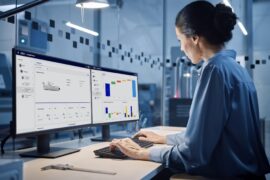Two new digital tools from Düsseldorf, Germany-headquartered GEA reduce water and power consumption during the cleaning of membrane filtration plants by up to 50%. The software duo, GEA Smart Filtration CIP and Smart Filtration Flush, automatically intervene in cleaning-in-place processes, pulsing the pumps and flushing the membranes individually and according to real-time water quality.
Membrane filtration plants separate or concentrate substances without thermal stress. Membrane filtration is primarily used in food manufacturing and in dairy processing. Common product examples include fish collagen isolates and dairy protein. Until now, cleaning this equipment was energy- and water-intensive, requiring three or four individual steps with different chemical cleaning agents to be pumped and circulated throughout the equipment for a specified amount of time before rinsing it out with water.
In contrast GEA Smart Filtration Flush uses sensors to constantly measure the permeate quality of water during the flushing process, reducing the freshwater required. Setting blanket rinsing intervals and water quantities in advance are no longer needed as the software stops the process as soon as the necessary hygiene level is reached, and the cleaning agents are discharged. Depending on the type and size of the plant and the water properties, operators can reduce their freshwater requirements by up to 50%.
“A typical dairy whey protein concentration process needs two to four filtration plants connected in a series. This set up can require more than 100,000 liters of water, per cleaning cycle,” explained Nils Mørk, research and development engineer for membrane filtration at GEA. “Today, we know from plant tests that we can save well up to 50,000 liters of water per cleaning in such large plants and 500 to 700 liters per CIP in small productions.”

Up to 50% Less Energy Thanks to Pulsating Pumps
GEA Smart Filitation CIP is a software module that regulates cleaning efficiency. It causes the pumps to operate in a pulsating manner as opposed to running continuously. As a result, the pumps consume up to 50% less energy during the CIP process. Traditionally, the best results were achieved by cleaning with high shear forces (e.g., mechanical washing with a strong rinse flow).This approach meant the maximum allowed pressure drop across the membranes was applied during the CIP process – which entails much higher energy consumption. GEA Smart Filtration CIP breaks with this inefficient method, without losing efficacy.
The Washing Machine Principle
Tests conducted by GEA on various membrane plants prove that the same level of hygienic cleaning is achieved even if the pump only operates at short intervals – providing the time, temperature and chemical concentration is kept constant.
“Our method, now applied to membrane plants, mirrors the basic principles used successfully by washing machines: agitate the clothes followed by intervals of rest, allowing the cleaning agent do its job,” said Mørk.
Compared to plants with standard pump operation at full load, small production plants with GEA Smart Filtration CIP would save between 5 and 7 kilowatt hours per cleaning. Large filtration plants would require 60 to 100 kilowatt hours less electrical energy per CIP process thanks to this innovation.





